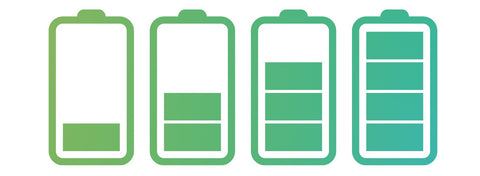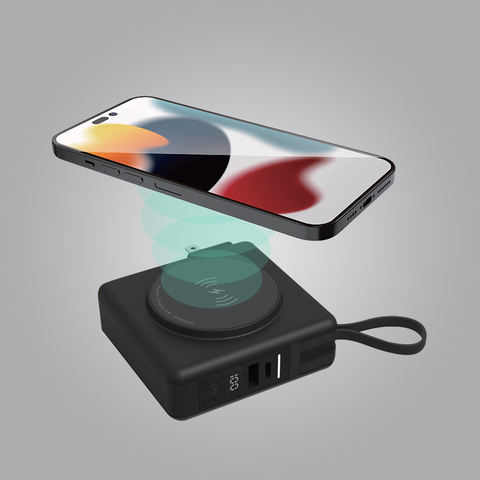

Power banks have become essential tools for keeping devices charged on the go. But for merchants and brands, understanding the science behind their energy storage and operational efficiency is crucial for selecting and marketing the best products. This knowledge can help businesses cater to consumer needs and differentiate their offerings in a competitive market.
Power banks store energy in lithium-ion or lithium-polymer batteries. These batteries are charged using an external power source, such as a wall outlet. The energy is stored chemically and later converted into electrical energy to charge devices. This three-step process—charging, storing, and discharging—is designed to optimize power delivery while maintaining efficiency.
Understanding this mechanism equips merchants to answer consumer questions and market their products effectively.
How Do Power Banks Store Energy?
At the core of a power bank are its batteries. These are typically either:
- Lithium-ion Batteries: Known for high energy density, these are commonly used in larger power banks that require significant capacity.
- Lithium-polymer Batteries: While these have slightly lower energy density, they are lightweight, flexible, and ideal for compact, portable designs.
The energy storage process consists of three steps:
- Charging: Power banks absorb energy from an external power source (e.g., wall outlets or USB ports).
- Storing: The absorbed energy is converted into a chemical form within the battery, where it remains stable until needed.
- Discharging: When a device is connected, the stored energy is reconverted into electrical energy and sent to the device via output ports.
The choice of battery technology significantly affects the size, weight, and capacity of a power bank, making it a key factor for merchants to consider when selecting products for specific markets.
How Much Energy Does a Power Bank Hold?
The capacity of a power bank is measured in milliamp-hours (mAh), with higher mAh values indicating greater storage capacity. For example:
- A 5,000mAh power bank can charge most smartphones once or twice.
- A 20,000mAh power bank can charge multiple devices multiple times, catering to heavy users or travelers.
However, capacity isn’t the only consideration:
- Voltage Differences: While batteries store energy at 3.7 volts, they output at 5 volts to charge devices. This conversion results in some energy loss, reducing the actual usable capacity.
- Efficiency Ratings: Power banks typically deliver 70-90% of their rated capacity due to heat generation, voltage conversion, and circuit operations.
Merchants should educate consumers on how to interpret capacity ratings and the real-world implications to set realistic expectations.
What Are the Energy Storage Systems in Power Systems?
Power banks are a subset of energy storage systems, which include various technologies designed to store and release energy. Understanding these systems provides insights into potential innovations and market trends. The five main categories are:
- Chemical Systems: These rely on chemical reactions to store energy, like the lithium-ion and lithium-polymer batteries in power banks.
- Electrochemical Systems: Common in industrial applications, they focus on reversible chemical reactions.
- Mechanical Systems: Examples include flywheels and pumped hydro, which are less relevant to portable devices.
- Thermal Systems: Storing energy as heat, primarily used in solar power applications.
- Electromagnetic Systems: Emerging technologies like supercapacitors, which offer rapid charging and discharging.
Merchants can look out for advancements, such as hybrid systems that combine chemical batteries with supercapacitors, to enhance power bank performance.
How Long Can a Power Bank Store Power?
A power bank’s longevity depends on its charge-discharge cycle, which typically ranges from 500 to 900 cycles. Here are some factors affecting their lifespan:
- Charge Cycles: Each cycle involves a full charge and discharge. Over time, this reduces the battery’s ability to hold a charge.
- Usage Frequency: Regular usage ensures consistent performance, whereas long periods of disuse can degrade the battery.
- Storage Conditions: Extreme temperatures or high humidity can damage the internal components.
On average, with proper use, a power bank can last about three years. Educating customers on these factors can improve product satisfaction and reduce warranty claims.
Customization Options for Merchants and Brands
Customization is a powerful way for merchants to differentiate their products and build brand recognition. Some popular options include:
- Design Personalization: Custom shapes, colors, and branding elements like logos can align with a merchant’s brand identity.
- Advanced Features:
- Fast-charging technology for rapid device charging.
- Multiple ports for charging several devices simultaneously.
- Solar panels for eco-friendly recharging.
- Eco-Friendly Materials: With growing consumer demand for sustainability, biodegradable materials and energy-efficient packaging can appeal to eco-conscious buyers.
Providing unique customization options not only enhances market appeal but also allows merchants to charge a premium for their products.
Emerging Trends in Energy Storage for Power Banks
The power bank market continues to evolve, with trends shaping the future of energy storage:
- Hybrid Energy Storage Systems: Combining lithium batteries with supercapacitors or other technologies to improve efficiency and lifespan.
- Tesla-Inspired Innovations: High-capacity, eco-friendly storage solutions, such as those used in electric vehicles, adapted for portable devices.
- Sustainable Designs: Solar-powered power banks and biodegradable materials are gaining traction, catering to environmentally conscious consumers.
- Smarter Power Management: Power banks with intelligent charging capabilities can optimize output for connected devices, preventing overcharging and extending device lifespan.
Merchants who stay ahead of these trends can capture the attention of forward-thinking customers.
Summary
Understanding energy storage in power banks empowers merchants and brands to make informed decisions about their product offerings. From selecting the right capacity to customizing for niche markets and leveraging emerging trends, these insights ensure you stay competitive. Partner with us to explore innovative solutions and elevate your offerings in the ever-evolving energy storage industry.







